|
Ingredients:
High fiber wheat bran*, high protein wheat flour*, barley, steel cut oats*, light and sweet molasses, honey,
golden brown sugar, organic milled flax seed*, canola
oil.
*: GMO free and from a local supplier (within 100 miles)
Note: We only use a light amber Grade A honey
made in the USA.
Q: Why honey you ask?
A: It started by trying to add some Vitamins
and Antioxidants in a natural way. After a few months
of research we have decided to use honey instead of corn syrup.
Benefits of Honey:
Hippocrates, the father of modern medicine, realized honey's
healing powers in the 1st century BC and prescribed it regularly to
his patients for such conditions as skin disorders, sores, ulcers, respiratory
ailments and fever. The physicians of Rome, prescribed honey to their
patients who had trouble sleeping and even today, we might have a glass
of warm milk sweetened with honey to help ensure a restful night.
Not only is honey a delicious natural sweetener, it is
a Nutritional Powerhouse. It contains many Vitamins,
including an important antioxidant called pinocembrin.
It also contains a full compliment of Minerals, which
are more important then ever due to the depletion in the soil. Nowadays,
many grains are fortified with synthetic nutrients; however, the body
can better utilize nutrients from whole foods than isolated nutrients.
Honey is also a carbohydrate and a source of energy for horses. The
University of Memphis Exercise and Sports Nutritional Lab found honey
to benefit muscles.
Honey's Powerful Infection Fighters
Perhaps one of the most ancient uses of honey as a healing
agent (as early as 2,500 BC) was for wounds, burns and cuts. As recently
as the First World War, honey was being mixed with cod liver oil to
dress wounds on the battlefield. It continues to be used by medical
professionals in many Eastern European countries to dress wounds today.
Honey forms a barrier to help prevent further infection of wounds and
burns.
Modern science now acknowledges honey as an anti-microbial agent, which
means it deters the growth of certain types of bacteria, yeast and molds.
Many properties of honey contribute to its anti-microbial function.
Its high sugar content robs micro-organisms of the water necessary for
their growth. Honey's low protein content and high acidity restrict
bacterial growth by limiting the amount of nitrogen available. The antioxidants
found in honey also aid this function.
Antioxidant Power for Supporting Good Health
Honey contains several compounds that help to eliminate
the free radicals in our bodies that contribute to many serious diseases.
Such compounds are called "antioxidants". In fact, one unique
antioxidant called "pinocembrin" is only found in honey. So
simply putting honey on your oatmeal or enjoying a cup of green tea
sweetened with a spoonful of honey, will help your body protect itself
from disease.
Enjoy some of our Bee pictures
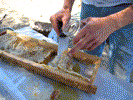 |
Greg is just harvesting
some of the fresh "organic" honey out of the frame.
This honey is very very sweet and is mostly from Elderberries
and sweet melons. |
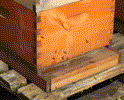 |
This Bee-hive is one of many
located on our farm. As you can see above, a hive consists of
many frames. |
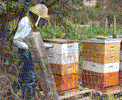 |
Greg is approching the bee hive
with his smoke can and his protective mask. The smoke is keeping
the bee's calm. We are about to open the hive. |
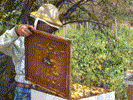 |
He is now opening the lid of
the hive, ready to take out a frame so we can taste the honey.
hmmmmm..... |
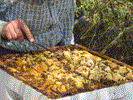 |
Now take a look at this! The
picture is of high resolution. You can really zoom in to see the
work of the honey bees (a.k.a. worker bee's). |
|

